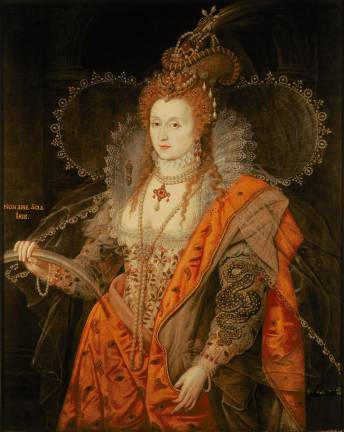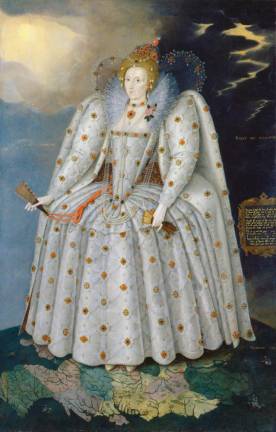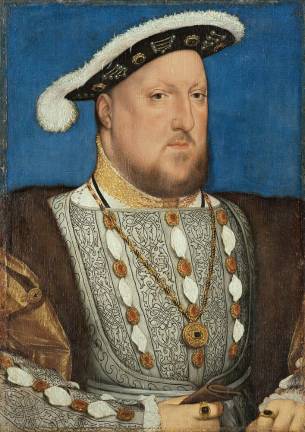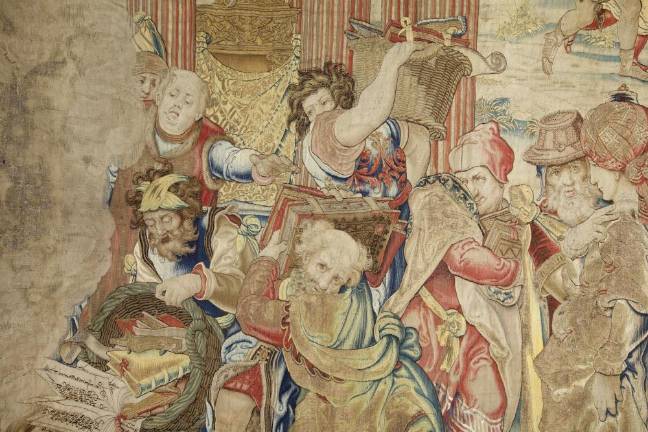Holbeins, Tapestries and a ‘Sea-Dog’ Table
A new exhibit at The Met is the first to showcase art created or acquired during the Tudor dynasty




Now that the Queen is dead and Charles has been proclaimed King, there could be no better time for The Met to stage “The Tudors: Art and Majesty in Renaissance England,” a show that has been in the making since 2016. Think of it as a warmup for next year’s coronation of the new monarch, and a throwback to another tumultuous political era.
You don’t have to be a Tudor freak or fan of “Wolf Hall” — or even an Anglophile — to appreciate the material culture and artistic splendor that reigned during the dynasty, which lasted from 1485 when Henry VII seized the throne to 1603, when Henry VIII’s daughter, Elizabeth, died.
That’s five monarchs in total: Henry VII, Henry VIII, Edward VI (Henry VIII’s only legitimate son, who died at 15 and was borne by third wife Jane Seymour), Mary I (daughter of Henry’s first wife Katherine of Aragon, known as Bloody Mary for her execution of Protestants) and Elizabeth I (daughter of Henry’s second wife Anne Boleyn, known as the Virgin Queen and dubbed illegitimate and worse because her father defied the Catholic Church and married Boleyn).
On a recent tour of the show, co-curator Adam Eaker, a European paintings specialist, made the point that the exhibit aims to strut the stuff of the Tudors across media — there are paintings, tapestries, vestments, armor, metalwork, woodwork, sculpture and manuscripts that are the handiwork of a very cosmopolitan set patronized by the English royals, their rich courtiers and kin.
The walls and display cases are replete with Flemish paintings and weavings, Florentine velvets and sculpture, plus a wealth of portraits by German master Hans Holbein the Younger, with materials like mother of pearl from India and porcelain from China added to the global mix.
Lifestyle of the Tudor Courts
It’s an immersive experience, with the more than 100 exhibit items arrayed in spaces, both large and intimate, meant to approximate the interior of a Tudor palace. The curators, Eaker and sculpture/decorative arts specialist Elizabeth Cleland, aim to simulate the lifestyle of the Tudor courts — put another way, make concrete what it means to be “to the manner born” and surrounded by Holbeins and luxurious furnishings and appointments, much of it portable so it can be transported from property to property as the occasion warrants.
The show opens with a giant candelabrum (1529-40) and two angels (1524-29) in bronze by Benedetto da Rovezzano, remnants of a tomb for Henry VIII that was never completed. The works are shown together for the first time since the 17th century and serve as prelude to a parade of magisterial pieces.
The portraits of the monarchs, especially a small painting of Henry VIII by Holbein (ca. 1537) and the many iterations of his daughter Elizabeth I, are dazzling statements about wealth and power, meant to impress foreign royals and project strength and legitimacy.
“The Ditchley Portrait” of Elizabeth by Marcus Gheeraerts the Younger (ca. 1592) is one of the most iconic likenesses of the Queen. (Eaker noted in his tour that the painting is so emblematic of the monarch that it is featured on the cover of his copy of the Norton Anthology of English Literature — mine too, seventh edition, volume 1.)
Golden Reign
The largest surviving full-length portrait of the Virgin Queen, “Ditchley” is a highly stylized portrayal, featuring a very stiff Elizabeth standing on top of a map of southern England, against the background of a bifurcated sky, half tempestuous (recalling her predecessor Mary’s reign), half sunny (representing her own golden reign).
There is nothing natural about this painting, except perhaps the Queen’s face, which shows signs of aging (subsequent copies were required to be, in effect, airbrushed to conceal unflattering attributes). Her Majesty wears a highly exaggerated costume featuring a hoop skirt known as a farthingale; her collar looks like a set of wings, as if she could take flight at a moment’s notice.
We get the overall impression that she’s no mere mortal — no mere Queen — but has near-divine, supernatural powers. She’s the master of all she surveys, a kind of 16th century superhero.
And this idea carries over into other renditions, such as “The Rainbow Portrait” attributed to Gheeraerts (ca. 1602), in which Elizabeth literally wields a rainbow and wears a cloak decorated with eyes and ears — because, yes, she sees it all, hears it all, and clearly knows it all.
Decorative arts fans will delight in the array of objets meant to please the eye and show off their owners’ ample coffers. The “’Sea-Dog’ Table” (ca. 1575), a rare survival from the 16th century, was made in France for English Countess Bess of Hardwick and her husband, Lord Shrewsbury. Per a video on the museum’s website, this banqueting table was meant to be disassembled — taken apart into seventeen pieces — and then reassembled wherever the party was, be it at the proprietor’s residence or another great house.
The “sea-dogs” are hefty mythical creatures that function as table legs; they have fishy, scaly bodies and dogs’ heads, each one quite individual. They rest on turtle-shaped feet and support the tabletop, which still boasts some of the original gilded silver ornamentation and Italian marble inlay.
It’s fit for a king — or queen.